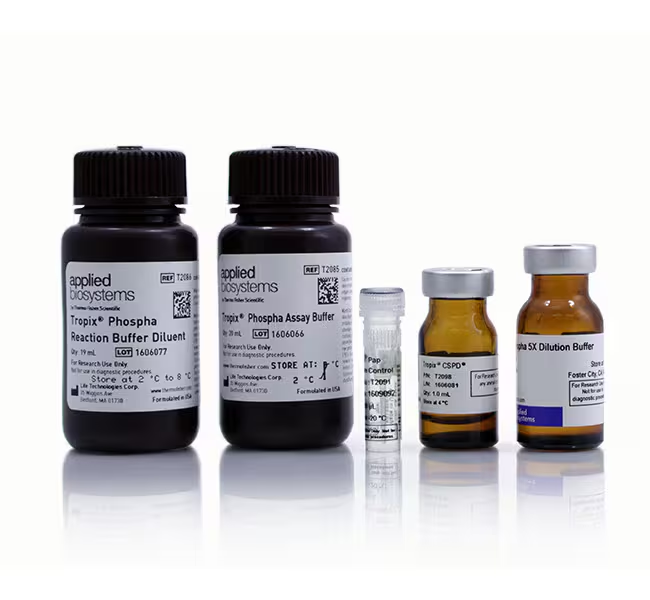
Phospha-Light™ assay system is a chemiluminescent reporter gene assay for the sensitive detection of secreted human placental alkaline phosphatase used as a reporter protein.
• Detection of a secreted reporter permits analysis without destroying valuable cells.
• Wide dynamic range of alkaline phosphatase assay lets the user measure enzyme level accurately from femtogram to nanogram range.
• Assay sensitivity is 100- to 1,000-fold better than with either the isotopic⁄non-isotopic assays for chloramphenicol acetyl transferase (CAT) or the colorimetric⁄fluorescent assays for b-galactosidase, providing greater sensitivity than competing assays.
• Highly sensitive assay with a wide dynamic range permits detection of high and low levels of reporter without the need to perform numerous sample dilutions.
• Non-radioactive reporter gene assay kit eliminates concerns over use of radioisotopes.
• Assay can be completed in about one hour, providing fast assay turnaround.
Monitor Expression Over Time
Phospha-Light™ assay system allows sensitive detection of secreted alkaline phosphatase (SEAP) reporter protein in cell culture media. The SEAP gene product is a truncated form of human placental alkaline phosphatase. A secreted reporter protein eliminates the need to prepare cell extracts. A population of cells can be monitored over time and remains intact for further experimentation.
Proprietary Reagents for Ultra-Sensitive Detection
Phospha-Light™ assay system is one of the easiest and fastest methods for optimizing transfection efficiency. A combination of proprietary reagents is the key to the highly sensitive detection achievable with the Phospha-Light™ assay. The system consists of CSPD™ high-performance alkaline phosphatase substrate, Emerald™ luminescence enhancer, and a unique buffer system designed to specifically inhibit non-placental endogenous alkaline phosphatase activity. The persistent glow of the chemiluminescent signal permits the use of luminometers without the need for injectors for measurement.
Applications
Phospha-Light™ reporter gene assay system has been used widely for reporter gene assays to measure gene expression in established cell lines and in transfected primary cells, including as a gene knockdown⁄RNA interference read-out. Phospha-Light reporter gene assay has been used for a wide variety of viral functional assays, including viral gene expression assays, viral replication, viral fusogenicity, virus neutralization and viral-mediated cell-cell fusion, and viral infectivity. Use of the SEAP reporter protein is very enabling for in vivo reporter gene assays, by assaying serum samples from transgenic, transfected or viral vector-infected animals. Phospha-Light reporter gene assay system has been used to measure SEAP levels in sera from transgenic or transfected whole animals, including mouse, rat, marmoset, monkey and pig sera, and in chicken egg allantoic fluid. The mouse SEAP protein (mSEAP) has recently been developed for improved SEAP protein stability in transgenic mice, and the Phospha-Light™ system has been used for sensitive detection of mSEAP. For these and additional references, please see our bibliography in the Literature⁄Resources section.
For Research Use Only. Not for use in diagnostics procedures.
| Code | Description |
|---|---|
| T1017 | Catalog Number: T1017 |
| T1016 | Catalog Number: T1016 |
| T1015 | Catalog Number: T1015 |

